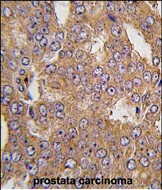NARS2 Antibody (C-term)
Purified Rabbit Polyclonal Antibody (Pab)
- SPECIFICATION
- CITATIONS
- PROTOCOLS
- BACKGROUND

Application
| IHC-P, WB, E |
|---|---|
| Primary Accession | Q96I59 |
| Reactivity | Human |
| Host | Rabbit |
| Clonality | Polyclonal |
| Isotype | Rabbit IgG |
| Calculated MW | 54090 Da |
| Antigen Region | 445-474 aa |
| Gene ID | 79731 |
|---|---|
| Other Names | Probable asparagine--tRNA ligase, mitochondrial, Asparaginyl-tRNA synthetase, AsnRS, NARS2 |
| Target/Specificity | This NARS2 antibody is generated from rabbits immunized with a KLH conjugated synthetic peptide between 445-474 amino acids from the C-terminal region of human NARS2. |
| Dilution | IHC-P~~1:10~50 WB~~1:1000 E~~Use at an assay dependent concentration. |
| Format | Purified polyclonal antibody supplied in PBS with 0.09% (W/V) sodium azide. This antibody is prepared by Saturated Ammonium Sulfate (SAS) precipitation followed by dialysis against PBS. |
| Storage | Maintain refrigerated at 2-8°C for up to 2 weeks. For long term storage store at -20°C in small aliquots to prevent freeze-thaw cycles. |
| Precautions | NARS2 Antibody (C-term) is for research use only and not for use in diagnostic or therapeutic procedures. |
| Name | NARS2 (HGNC:26274) |
|---|---|
| Function | Mitochondrial aminoacyl-tRNA synthetase that catalyzes the specific attachment of the asparagine amino acid (aa) to the homologous transfer RNA (tRNA), further participating in protein synthesis (PubMed:25385316). The reaction occurs in a two steps: asparagine is first activated by ATP to form Asn-AMP and then transferred to the acceptor end of tRNA(Asn) (Probable). |
| Cellular Location | Mitochondrion matrix. Mitochondrion |

Thousands of laboratories across the world have published research that depended on the performance of antibodies from Abcepta to advance their research. Check out links to articles that cite our products in major peer-reviewed journals, organized by research category.
info@abcepta.com, and receive a free "I Love Antibodies" mug.
Provided below are standard protocols that you may find useful for product applications.
Background
Asparagine-tRNA ligase (EC 6.1.1.22) catalyzes the chemical reaction: ATP + L-asparagine + tRNAAsn <---> AMP + diphosphate + L-asparaginyl-tRNAAsn. This enzyme participates in alanine and aspartate metabolism and aminoacyl-tRNA biosynthesis.
References
Bonnefond,L., Biochemistry 44 (12), 4805-4816 (2005)
If you have used an Abcepta product and would like to share how it has performed, please click on the "Submit Review" button and provide the requested information. Our staff will examine and post your review and contact you if needed.
If you have any additional inquiries please email technical services at tech@abcepta.com.













 Foundational characteristics of cancer include proliferation, angiogenesis, migration, evasion of apoptosis, and cellular immortality. Find key markers for these cellular processes and antibodies to detect them.
Foundational characteristics of cancer include proliferation, angiogenesis, migration, evasion of apoptosis, and cellular immortality. Find key markers for these cellular processes and antibodies to detect them. The SUMOplot™ Analysis Program predicts and scores sumoylation sites in your protein. SUMOylation is a post-translational modification involved in various cellular processes, such as nuclear-cytosolic transport, transcriptional regulation, apoptosis, protein stability, response to stress, and progression through the cell cycle.
The SUMOplot™ Analysis Program predicts and scores sumoylation sites in your protein. SUMOylation is a post-translational modification involved in various cellular processes, such as nuclear-cytosolic transport, transcriptional regulation, apoptosis, protein stability, response to stress, and progression through the cell cycle. The Autophagy Receptor Motif Plotter predicts and scores autophagy receptor binding sites in your protein. Identifying proteins connected to this pathway is critical to understanding the role of autophagy in physiological as well as pathological processes such as development, differentiation, neurodegenerative diseases, stress, infection, and cancer.
The Autophagy Receptor Motif Plotter predicts and scores autophagy receptor binding sites in your protein. Identifying proteins connected to this pathway is critical to understanding the role of autophagy in physiological as well as pathological processes such as development, differentiation, neurodegenerative diseases, stress, infection, and cancer.



